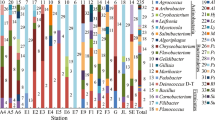Abstract
Four topsoils and three subsoils from an arable field, two grasslands and a beech forest with different ecophysiological properties were investigated for the most abundant proteolytic bacteria. The number of proteolytic bacteria was estimated with the most probable number (MPN) assay using a gelatin-based medium. Subsequent isolations of bacteria were performed on a gelatin-based agar medium. No coherence was observed between site specific properties, MPN counts of proteolytic bacteria and proteolytic activities at the different sites. In the subsoils proteolytic activity was considerably lower than in the corresponding topsoils. Differences in MPN counts of proteolytic bacteria were only significant for the arable field profile in March, with lower values in the subsoil. Pseudomonas fluorescens was the most abundant proteolytic species in all investigated horizons except for the acidic topsoil of the beech forest. Bacillus cereus and B. mycoides were also prominent especially in the topsoils and were less abundant in the subsoils. Flavobacterium-Cytophaga bacteria were enriched in autumn, but were lacking in the beech forest horizons and in the topsoil of the arable field. The results of inhibition assays suggest that the extracellular peptidases formed by these species were metalloenzymes.
Similar content being viewed by others
Author information
Authors and Affiliations
Additional information
Received: 20 May 1999
Rights and permissions
About this article
Cite this article
Bach, HJ., Munch, J. Identification of bacterial sources of soil peptidases. Biol Fertil Soils 31, 219–224 (2000). https://doi.org/10.1007/s003740050648
Issue Date:
DOI: https://doi.org/10.1007/s003740050648



